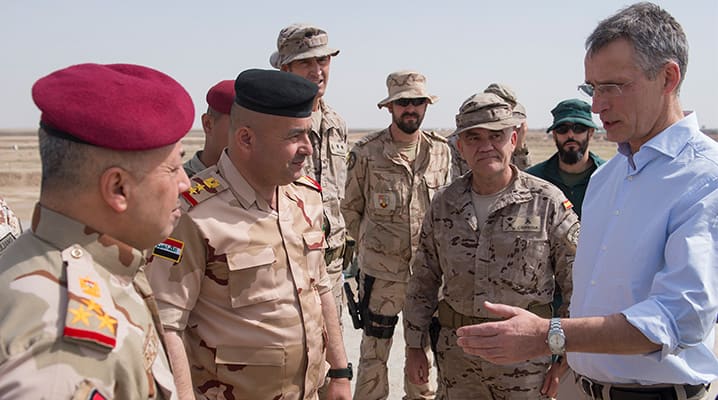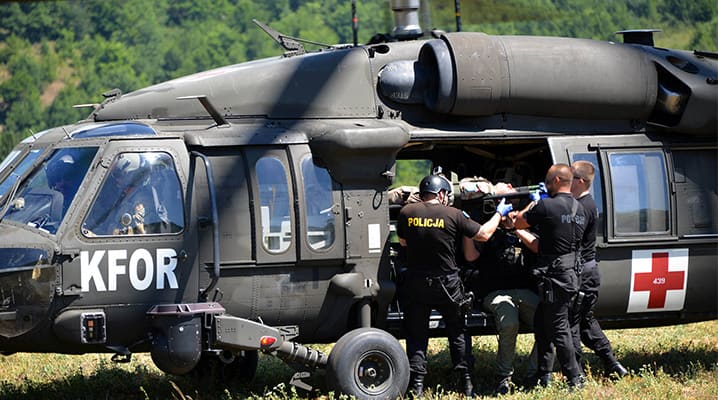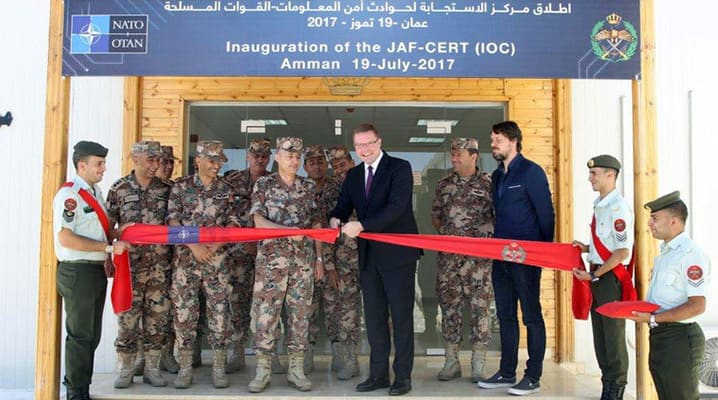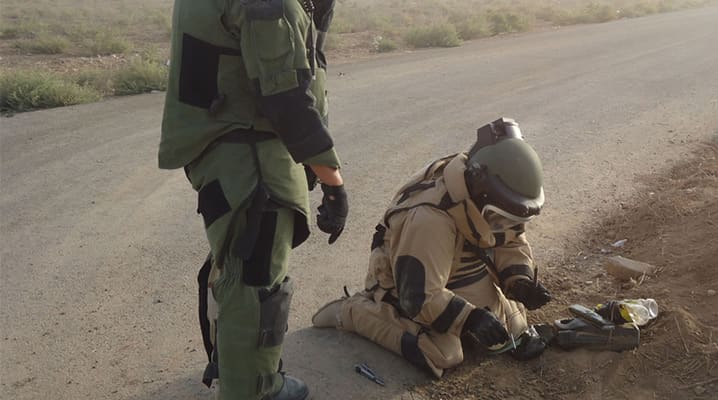“If NATO’s neighbours are more stable, NATO is more secure.” This statement is at the heart of NATO’s work on Projecting Stability, a concept launched by Allied leaders at the NATO Summit in Warsaw in 2016. Two years on, with a view to the next NATO Summit in Brussels in July 2018, it is worth taking stock of this concept and looking at where we may be headed.
First, it’s important to start with the statement. The phrase is simple, but profound in its implications.
Consider the context: two years after the end of the NATO-led International Security Assistance Force operation in Afghanistan, and the shock of Russia’s illegal annexation of Crimea and the crisis in eastern Ukraine, NATO was busy consolidating its enhanced defence and deterrence posture. At Warsaw, key steps were taken in this regard. There was some speculation as to whether we were witnessing a “back to the future”: a return to a Cold War-era collective defence organisation. This would mean setting aside or downplaying NATO’s significant crisis management and cooperative security roles built up since the early 1990s, including its large network of partnerships with third states.

NATO Secretary General Jens Stoltenberg talks to NATO trainers and Iraqi troops during a visit to the NATO Training Camp in Iraq on 5 March 2018. Allied defence ministers agreed in February 2018 to start planning for a training mission to deepen NATO’s defence capacity building support for the country. © NATO
Nonetheless, by stating that NATO’s security is linked to the stability of its neighbours, Allied leaders made clear that they were not pulling up the drawbridge of fortress NATO. On the contrary, they stated in no uncertain terms that the security of NATO’s members is intimately linked to the stability of its neighbouring regions and states. This was not just a pious aspiration but also a conclusion etched in the memories of recent experience. Since 2014 alone, NATO had seen how developments in its neighbours to the east and south – in Ukraine, Iraq and Syria – could have profound implications for the security of its own citizens.
With this recognition also came a commitment to do something about it. At Warsaw, Allied leaders signed up to an agenda for action – known as Projecting Stability – that sets out measures to help the Alliance prepare for, deal with and overcome instability in its neighbourhood, including with its partners. It is seen as a holistic approach with a spectrum of engagement, running from partnerships with key states, including capacity building, to crisis management measures relying on military capabilities.
At Warsaw, the Allies announced a number of measures that showed, concretely, how this was being implemented: deeper capacity building support to partners such as Ukraine, Georgia, Iraq and Jordan; maritime security activities in the Mediterranean and the Aegean; and support for the Global Coalition to Counter ISIS (or Daesh).
No ‘fortress NATO’
By stressing their commitment to ‘projecting stability’, Allied leaders underlined that despite the deteriorating security conditions, NATO is not moving away from its comprehensive approach to security, leaving behind cooperative security and crisis management.
A few months later, in a speech at the Harvard Kennedy School, Secretary General Jens Stoltenberg explained that NATO is entering a third phase of its history: after the first phase of collective defence (1949–1991), and the second phase of ‘projecting stability’ through crisis management and partnerships (1991–2014), NATO is in a third phase in which it: “must do both collective defence and manage crisis and promote stability beyond our borders” and does not “have the luxury of choosing one or the other.”
Allied leaders recognised at Warsaw that the security challenges of our times still require the broad and comprehensive spectrum of tools and policies that it developed in the post-Cold War period. At the same time, they saw that just as NATO had to adapt to deal with enhanced defence and deterrence tasks, the Alliance had to evolve so that “NATO has a long-term and sustainable approach to projecting stability with adequate and sustainable resources and structures, making best use of existing funding mechanisms.”
This is potentially a broad agenda. But NATO is no stranger to ‘projecting stability’. The Alliance can point to a strong, post-Cold War track record of contributing to stabilisation outside its borders, and beyond its core task of collective defence. Its crisis management operations in Bosnia and Herzegovina, Kosovo and Afghanistan – as well as its capacity building activities in Iraq – were essentially stabilisation missions, often with a strong training component.

The NATO-led Kosovo Force, which was first deployed in 1999, has over the years supervised the stand-up and training of a multi-ethnic, professional and civilian-controlled Kosovo Security Force. Since 2017, a NATO Liaison and Advisory Team has provided capacity building support to security organisations in Kosovo from the executive to the force level. Pictured: A medical evacuation exercise takes place in Kosovo. © KFOR
Furthermore, NATO has more than a quarter of a century’s experience in advising, supporting and mentoring partner states to achieve defence and institutional reform, build capabilities and strengthen interoperability. Much of that expertise has been built up in working with the more than a dozen countries that were preparing to join the Alliance – but not only: NATO’s network of partners is now more than 40 strong and reaches around the world. Beyond political dialogue, the practical reality of these relationships is often focused on building capacity, through strategic advice, education, training, exercising and evaluation, at both the level of institutions and of individual units.
Increased focus on the South
Increasingly, the ‘southern neighbourhood’ is associated with NATO’s Projecting Stability concept. Traditionally Alliance efforts to project stability through partnerships and defence reform had a strong focus on NATO’s eastern neighbourhood (Central and Eastern Europe, the Western Balkans and the former Soviet Union). However, since the so-called Arab Spring, NATO has seen a gradual but steady increase in work with its Middle East and North Africa partners, complementing its work with the Eastern partners.
Much of this stepped up support for the South has been focused on partners in NATO’s Mediterranean Dialogue and Istanbul Cooperation Initiative formats. Many of NATO’s southern partners have been brought together in a new partnership forum, the Interoperability Platform, which is designed to maintain and deepen operational connectivity between NATO and its partners for future crisis management and stabilisation operations.
NATO has also been stepping up efforts to develop education and training opportunities for its partners. In early 2017, the Allies and Kuwait inaugurated a regional centre in Kuwait to serve NATO’s partnerships with Gulf countries.
In specific cases, NATO has focused its partnerships with southern partners more explicitly on building their defence capacities and institutions. For instance, in 2014 Jordan started receiving support consisting of enhanced training, assistance and advice through an integrated package of defence capacity building.
The Warsaw decisions confirmed this trend and produced new initiatives such as the launch of a training and capacity building activity in Iraq, on the basis of which NATO defence ministers agreed in February 2018 to start planning for a training mission.
Looking forward
Looking forward, what should change? How should this agenda continue to evolve? How should it retool itself to project stability?
It is very likely that part of NATO’s efforts to ‘project stability’ will require some form of crisis management activity or operation. However, NATO – by and large – has a lot of experience, having run a number of these since the end of the Cold War. It has the procedures, the know-how, and the structures to run them. At the same time, any future NATO crisis management mission will be a unique scenario, responding to a very specific contingency and under different political circumstances. It is hard to predict when and where it will be asked to contribute.
If we set crisis management aside, the bread and butter of NATO’s work to project stability in the future will continue to revolve around prevention: the patient and long-term task of developing partnerships through political engagement and cooperation in order to strengthen partners’ institutional capacity to face security challenges.

NATO and the Jordanian Armed Forces inaugurated the newly established Computer Emergency Response Team (CERT) in Amman on 19 July 2017. Efforts to enhance Jordanian cyber defence capabilities are part of a wider defence capacity building package for Jordan. © NATO
This work will never be as visible as other aspects of NATO’s engagement, but it remains essential. Indeed, former Supreme Allied Commander for Europe General Breedlove argued in an article in July 2016 that with regards to the Middle East NATO’s “main strategy should be to invest in institution building and education, among other measures, to stabilise the poorly governed spaces that give rise to terrorism and displaced populations.” NATO’s Secretary General has also consistently argued that investing in developing local institutions and forces is a cost-effective means to prevent and fight terrorism and destabilisation.
In taking forward its Projecting Stability agenda, NATO will need to reflect on the overall ends, ways and means that it will use to ‘project stability’ through partnerships and capacity building in the years to come.
Ends
In the late 1990s and early 2000s NATO’s partnerships in Europe and the former Soviet Union were taken forward under the political slogan of a “Partnership for Peace” – a building block towards building a vision of a “Europe whole and free”: a cooperative, peaceful, post-Cold War European order. Now that ‘projecting stability’ is the new leitmotiv, it is worth reflecting on what overall political project or finalité such efforts will serve. Does NATO – or the West as a whole for that matter – have an equivalent vision for its regional partners in North Africa and the Middle East? Surely creating the conditions for defeating terrorism would be part of an answer, but is it enough? In any case, political visions matter for a number of reasons.
First, what defines the ‘neighbourhood’ has changed. NATO’s focus on ‘projecting stability’ in the 1990s and 2000s was on a relatively homogeneous group of countries, defined by their post-Communist heritage and common desire to join Euro-Atlantic structures. In the 1990s, the enlargement of NATO and the European Union worked in tandem, creating a powerful mix of conditionality driving transformation of states and societies.
Now, geopolitics is back. NATO’s neighbourhood is a much more diverse – and contested – environment. Unlike in the “unipolar moment” of the 1990s, the geopolitical environment is marked by the rise of powers (on the international scene) and movements (domestically) that aggressively contest and challenge the multilateral rules-based order that NATO upholds.
When it comes to the Middle East and North Africa, the very nature of the regional order is perceived to be in play. Many outside powers are investing significantly in building and deepening relationships with some of NATO’s partner countries with a view to influencing this regional order. At the same time, enlargement – and its powerful conditionality machine – is not on the table for most of these partners. Since Montenegro joined the Alliance in 2017, only a few of NATO’s 40+ partners remain official candidates for membership.

Strengthening partners’ abilities to fight terrorism is an important part of NATO’s defence capacity building work with southern partners. Pictured: Trainers share expertise on countering improvised explosive devices. © NATO
The overall diversity of NATO’s partner relationships means that some of the more ‘wholesale’ mechanisms of partnership and capacity building of the 1990s – designed to guide more than a dozen states into NATO – will need to become more tailored to suit a much more diverse set of circumstances in each of NATO’s partner countries. At the same time, in the absence of the conditionality lever that enlargement offered, it will be important to think about how to reinforce incentives for partners that address their interests and encourage them to cooperate with NATO and to work towards developing more modern, resilient and capable defence institutions.
Ways and means
On a day-to-day basis, NATO will be working with its partners and other countries that may request its expertise through its partnership tools and capacity building programmes. Here, there is a real agenda for change that needs to be taken forward.
This is an area where NATO almost has too much experience. After a quarter century of working with partners, it has developed an elaborate, if not complex, acquis of tools, instruments and mechanisms. The challenge is how to streamline and organise these tools in order to better ‘project stability’.
Thankfully, the Allies have set some guidance for this purpose: at Warsaw, they stressed the importance of developing a “long-term and sustainable approach to projecting stability”. Two elements are worth thinking about in more depth.
First, sustainability. This means that whatever capacity building assistance is given by NATO will continue to produce effects after NATO diminishes or ends its support to a partner country. Experience suggests that this can only happen if change or reform is embedded into institutions and their systems, procedures, mindsets and cultures.
Since Warsaw, the Allies have reconfirmed the importance of what in NATO parlance is called defence institution building. What does this mean in practice? For example if a partner country develops a Special Operations Force, it is not enough to train and equip the force. It will also need to set in place the arrangements with its defence ministry and general staff to make sure that the role of the Force in national defence strategy and doctrine is well understood; that recruitment and financing procedures are tailored to the needs of the Force; and that adequate education and training institutions are established to keep up the Force’s knowledge and skills. All of this – and more – ensures that the new Special Operations Force becomes more sustainable.
Second, helping partners to develop institutions is potentially a long-term project. It requires thinking holistically about security and defence institutions. From the NATO side, this can only happen if the Organization can see the bigger picture of its cooperation with a country, so that it can then work in a more joined-up way with the country. For this purpose, Allies have also directed staffs to move towards a ‘One NATO’ approach in working with partners: civilian and military staffs working with one partner will need to work together on a more systematic basis.
Leveraging support to maximise impact
Finally, it is worth thinking about the structures and resources that NATO will need to project stability. Three strategies in particular should be developed further: exploiting and developing networks; partnering with the European Union; and deepening the use of voluntary financial contributions.
First, NATO’s partnerships show how networks can be used to make few resources go a long way. Many of NATO’s programmes for partners work with a relatively small funding pool but then attract a range of in-kind voluntary donations that multiply what NATO’s common budget invests many times over. The same thing happens with expertise. NATO staff are able to draw on networks of expertise across Allied and partner countries to conduct training, advice and mentoring – this includes the two dozen Centres of Excellence on subjects as varied as cyber, military medicine and strategic communications, as well as its Partnership Training and Education Centres.

Projecting stability in different regions is one of the priorities for NATO-EU cooperation, which were set out in a Joint Declaration signed in Warsaw in July 2016 by (left to right) President of the European Council Donald Tusk, NATO Secretary General Jens Stoltenberg and President of the European Commission Jean-Claude Juncker. © NATO
This flexible model could be developed further. To generate the support needed to support and advise partner countries, NATO’s political and military staffs need to become experts at generating, managing and using such networks of expertise across Allied and partner defence and military institutions, academia and civil society. Already, the new Southern Hub has embraced this philosophy, centring its work on “connecting, consulting and coordinating” with a range of actors to better understand the challenges and opportunities to NATO’s south.
Second, there is a lot of potential in deeper partnership with a key strategic partner of NATO: the European Union. The two organisations share a common neighbourhood, and a common commitment to the resilience of their neighbours. Working together on defence capacity building is one of the core areas for deeper cooperation identified in a Joint Declaration, signed by the organisations’ leaders at Warsaw in July 2016. Leveraging the expertise and financial resources of both NATO and the European Union in support of joint projects in partner countries would be a significant way of strengthening a ‘networked’ approach to ‘projecting stability’.
Finally, financial resources. NATO already has an excellent tool at its disposal, its so-called Trust Funds. These allow individual Allies and partners, with the support of NATO staffs, to volunteer additional funding for a specific reform or capacity building project. These funds have actually generated more funds than what is available on a yearly basis in NATO’s core budget. If Allies and partners are to step up support in future years, it is essential that this financing arrangement is ready to accommodate potentially increased support.
As NATO gears up for the 2018 Summit, ensuring that its structures are prepared to tackle the challenge of realising the Projecting Stability agenda will be a key test. However, NATO can build on the significant progress made since Warsaw, in particular when it comes to defining the role of partnerships and capacity building.
